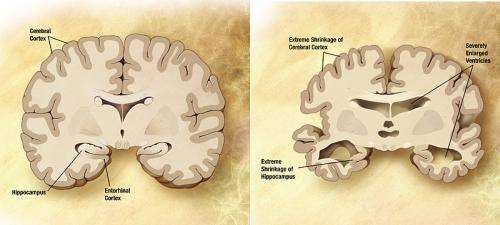Designer protein gives new hope to scientists studying Alzheimer's disease

A new protein which will help scientists to understand why nerve cells die in people with Alzheimer's disease has been designed in a University of Sussex laboratory.
In people with Alzheimer's, Amyloid-beta (Abeta) proteins stick together to make amyloid fibrils which form clumps between neurons in the brain. It's believed the build-up of these clumps causes brain cells to die, leading to the cognitive decline in patients suffering from the disease.
It is not known why this particular protein's "stickiness" causes cells to die and scientists have been unable to properly test whether the sticky clumps of Abeta proteins have different effects, compared with individual proteins that are not stuck together.
Now University of Sussex scientists have created a new protein which closely resembles the Abeta protein in size and shape, but contains two different amino acids (the building blocks that proteins are made up of). These changes mean that the new protein does not form amyloid fibres or sticky clumps, and, unlike Abeta, is not toxic to nerve cells, according to a study, published today (22 July) in the open access Nature Publishing Group journal, Scientific Reports.
The new protein will be an essential laboratory tool for researchers working to understand the causes and role of Abeta plays in Alzheimer's disease. The scientists who designed it are now working closely with the Sussex Innovation Centre, the University's business-incubation hub, to research commercial opportunities for the protein.
Dr Karen Marshall, who lead on the study said: "Understanding how the brain protein Abeta causes nerve cell death in Alzheimer's patients is key if we are to find a cure for this disease.
"Our study clearly shows that the aggregation of Abeta into bigger species is critical in its ability to kill cells. Stopping the protein aggregating in people with Alzheimer's could slow down the progression symptoms of the disease. We hope to work towards finding a strategy to do this in the lab and reverse the damaging effects of toxic Abeta."
Professor Louise Serpell, a senior author on the study and co-director of the University of Sussex's Dementia Research Group, said: "This is a really exciting new tool that will contribute to research to uncover the causes for Alzheimer's disease and enable tangible progress to be made towards finding targets for therapy."
Peter Lane, Innovation Support Manager at The Sussex Innovation Centre said: "This is an really exciting development. The Centre is thrilled to be working alongside Professor Serpell to make sure the benefits offered by this new laboratory tool are made widely available to the Alzheimer's research community in the very near future."
The study 'A critical role for the self-assembly of Amyloid-β1-42 in neurodegeneration' has been published in the open access Nature Publishing Group journal, Scientific Reports.



















